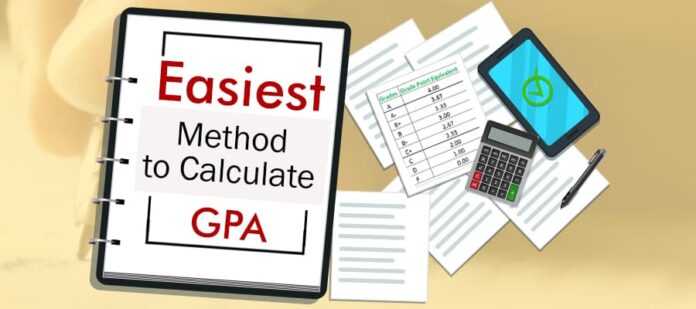In this article, we are going to tell you about GPA, How to calculate GPA from marks in Pakistan, How to calculate gpa of semester and all the other necessary details. So, this is going to be super useful for you, whether you are a high-school/college/university going student, or a teacher or even a parent.
Every student, at some stage, most probably has questions like How do I calculate my GPA step by step? What is the formula for GPA? How can I raise it? Do I have time? And many more.
Luckily, and that’s why this post, and our knowledge, is only here to help. We are here to break through rubbish, and help you analyze the data so that know where you’re going academically.
What exactly does GPA mean?
GPA stands for “grade point average” and it is the sum of a student’s high school/ college/university grades, calculated using a point system, and dividing with the total classes that the student attended.
University/College/ graduate school admissions officers, as well as prospective employers, see your grade point average to determine how well you’ve done educationally and whether you have the potential to be successful.

In this post, we will examine why your GPA is significant, the difference among a weighted and an unweighted GPA, and many other things and concept related to GPA.
Why is GPA important?
The grade point average (GPA) of a student can tell them a lot about their academic achievement, and it could be used to get them into higher school or get them a job. Student that hold a great grade point average (GPA) could be able to pass with honors or to continue their education in graduate school. It is a valuable indicator that can be used to determine how well a student is doing in his or her overall education.

When a high school student applies for college scholarships, it might demonstrate his or her commitment to academic excellence. When a student applies to work with an organization or club, it can help decide whether he or she will be successful. It is beneficial in the application process for graduate programs. Having a strong work ethic can be beneficial when applying for entry-level professions. It is a significant aspect in determining college admittance.
Cumulative vs. Semester GPA
The Grade Point Average (GPA) for a semester or term is the average of your grades for that particular term or semester. Your cumulative grade point average (GPA) is the average of all courses you have attempted in the program. It is calculated by adding together all the grade points obtained during the semesters and calculating the cumulative grade point average (GPA).
Types of GPA
weighted and unweighted are the major types of GPA.
Weighted GPA
It is when an institution utilizes a scale that ranges between 0.0 all the upwards from to 5.0 (or even sometimes 6.0) and takes into account hardship of the classes taken. In this arrangement, grades achieved in honours, AP, and/or IB classes are given a numerical value that is higher than other grades.
Unweighted GPA
This is when a school adopts a scale that ranges from zero to four points and therefore does not consider the level of difficulty of the courses.
In this, A student’s GPA of 3.0 represents a B average, whereas a grade point average of 1.0 suggests an F. Due to the fact that it ignores severity of the classes taken, a student that received a B average in all honors classes would have the same GPA as a student who received the same B average in all lower-level subjects.
For example
Here’s an illustration to help you understand the differences between the two. Consider the following scenario: Aisha receives an A in a standard-level US History course, whereas Fatima obtains an A in AP US History. When it comes to the unweighted GPA model, both A’s are treated the same way, and each is equivalent to a 4.0.
However, according to the weighted GPA model, Aisha’s A would turn to a 4.0 and Fatima’s A would transform to a 5.0, demonstrating that her class required significantly more effort to pass.
You see the difference, don’t you?
How to Calculate GPA?
You must sum up all of the values in a table or on a scale, and then divide this sum by the total number of values presented in order to arrive at an average. The most difficult aspect of calculating a grade point average would be that it involves letter grades rather than just integers and decimals. So, before you can compute your grade point average, prepare yourself for some conversion work.
Here we will mostly talk about unweighted GPA, because it is the most commonly used one across the globe.
GPA Scale
First and foremost, you must transform each of your final marks into the appropriate decimal place in order to determine your grade point average (GPA). Here’s a straightforward scale for accomplishing this:
| Grade | Percentage | GPA |
| A+ | 97-100 | 4.0 |
| A | 93-96 | 4.0 |
| A- | 90-92 | 3.7 |
| B+ | 87-89 | 3.3 |
| B | 83-86 | 3.0 |
| B- | 80-82 | 2.7 |
| C+ | 77-79 | 2.3 |
| C | 73-76 | 2.0 |
| C- | 70-72 | 1.7 |
| D+ | 67-69 | 1.3 |
| D | 65-66 | 1.0 |
| F | BELOW 65 | 0.0 |
What is the formula for GPA?
GPA Formula is:

Step-by-Step Procedure:
Students often ask questions like What are the 4 steps needed to calculate his GPA? How to calculate GPA calculator, what is the step-by-step method of calculating GPA. So here is the complete guide for you:
- Calculate your grade in each class, as well as the amount of credit hours you have been given to each class.
- Make a conversion between each letter grade and its numerical equivalent point.
- For each class, multiply the number of credit hours obtained by the number of numerical equivalent points earned in that semester.
- For the academic year, add up the number of hours you have spent in each of the classes you have taken.
- The cumulative grade point average (GPA) for the academic year is computed by dividing the number of grade points by the total amount of credit hours.
Now let us see these steps one by one in detail:
Step 1:
The first step is to figure out what your grade was for each class and how many credit hours were assigned to each class you took throughout the year of academic or semester, respectively.
Consider the case of Aisha, who attended 4 courses in one academic year and received the following grades: As (A+), As (B), and As (B), as well as the following credit hours: 3, 4, 3, 3, respectively.
Step 2:
Then, using the GPA system at your institution, convert the various letter grades you’ve received for every class you’ve taken into decimal figures. Decimal numerals are typically around zero and four digits in length.
Using the scale mentioned above, the grade point for each score in Aisha’s example is:
A = 4.0
A+ = 4.0
B = 3.0
B = 3.0
Step 3:
In this step, it is necessary to multiply each one of the grades by the no of credit hours for every class, as established in step 2, to arrive at a final result. As an illustration, consider:
Class no 1: A = 4.0 x 3 = 12.0
Class no 2: A+ = 4.0 x 4 = 16.0
Class no 3: B = 3.0 x 4 = 12.0
Class no 4: B = 3.0 x 3 = 9.0
Total: 49.0
Step 4:
The very next step is to compute the total number of credit hours earned across all of the courses. By continuing to use the same case, the overall number of credit hours equals: 3+4+4+3 = 14.
Step 5:
Lastly, divide the total number of grade point (as established in step 3) by the total number of credit hours (as calculated in step 4) to obtain the cumulative grade point average (GPA) for the academic year in question. As an illustration:
The total number of grade points is 49.0.
Total number of credit hours: 14
Jackie’s grade point average is 49.0/14 = 3.5.
Wrapping Up
This was all about GPA , its types and its method of calculation along with its importance.
Your grade point average (GPA) does not define you; and besides, it would be impossible to sum up your educational background, personality, and abilities into a single number. The fact that you kept your grades up is a powerful indication to universities and employers of how carefully you treated your studies and how persistent you were in keeping your grades.

A good grade point average is well worth the effort because it will open doors to further education or employment prospects. Fortunately, the procedures for maintaining or improving your grade point average are uncomplicated.
If you find this article to be of helpful to you, please forward it to your friends so that they can benefit as well from our efforts.


